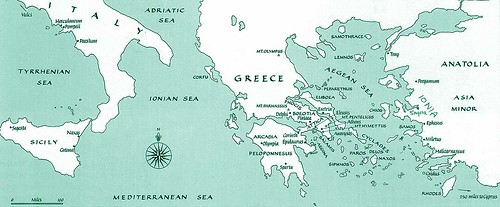
Image : http://www.flickr.com
The sculptural decoration of the great temple of Athena was eminently worthy of its architecture. Pheidias made his name immortal by creating a work that will eternally remain a model of Greek sculpture. The subjects, the composition, everything was of matchless perfection.
The Doric frieze sculptured in high relief above the outer colonnades consisted of ninety-two metopes: fourteen on each front and thirty-two on each side. Of the few that remain twenty-eight are to be seen on the east, thirteen on the north and one on the south, but all these are either badly weathered or so defaced as to be unrecognizable. Fifteen metopes are in London (others were lost in a shipwreck near Cape Maleas while being transported to England) and one in Paris. Those on the east represent battles between Gods and Giants; on the west between Athenians and Amazons; on the south between Centaurs and Lapithae, and on the north scenes from the Siege of Troy.
The tympana in the pediments, 28.65 m. in length by 3.45 m. in height, were filled with Pheidias' finest sculpture. That on the eastern pediment represented the Birth of Athena and showed her clad in full armor, springing forth from the head of Zeus. On the western pediment was represented the Contest between Athena and Poseidon for the possession of Attica. The two divinities occupied the center of the pediment and were shown standing, separated by the olive tree symbolizing the victory of the Virgin Goddess. Of all these statues, totalling fifty, almost nothing remains in situ. The vast majority was transported to London by lord Elgin and are now displayed in the British Museum; copies may be seen in the Museum of the Acropolis.
A continuous Ionic frieze 159.70 m. in length and 1 m. in height, carved in low relief, ran along the top of the outer walls of the naos and represented the ritual procession of officials, high born youths and maidens, Athenian citizens and resident aliens, and trains of sacrificial animals during the feast of the Greater Panathenaea, held every four years.
The beginning of the procession is shown in the south west angle of the frieze with the celebrants moving in double files from west to east; those on the north from the right, those on the south from left to right, towards the entrance at the east end of the temple, where the twelve Gods of Olympus preside over the ceremonial folding of Athena's peplos. On the west portion of the frieze knights are shown preparing for the cavalcade. One of them with his chlamys streaming in the wind makes ready to mount his rearing horse; another is shown fastening his sandal while his attendant bridles his master's restive steed; in a corner of the frieze, an official marshals the groups of cavalrymen who are seen moving off under their commanders.
With the exception of the three central figures, the western section of the frieze is still in situ, though in a very decomposed state; a great portion of that belonging to the northern, southern and eastern sides is in the British Museum, while the remainder, with the exception of eight pieces in the Louvre, is in the Museum of the Acropolis. The sight of this stupendous frieze in the days when it was surmounted by richly painted mouldings under a coffered ceiling ornamented with stars and flowers must have been overwhelming. The total number of figures represented in the frieze is estimated at three hundred and fifty pedestrians and one hundred and twenty-five equestrians, and no two figures are alike.
At the western end of the cella stood Pheidias' masterpiece; the cult-statue of Athena Parthenos. The site is clearly seen in the oblong of dark colored limestone in the center of which is a square opening. This held the main prop that supported the towering statue of the virgin goddess, constructed of gold and ivory over an inner wooden frame; including the pedestal it stood 12.80 m. high.
According to Pausanias, the goddess was standing, clad in a peplos. Her face, hands and feet were of ivory, while the peplos like the armor and accessories, was constructed of detachable gold plates, and could be removed in an emergency. On her left was her shield decorated with scenes from the battles between Greeks and Amazons on the outer side and Giants and Gods on the inner. Under the shield was a golden serpent representing Erechtheus. On her breast she wore the aegis with the Gorgon's head, and her helmet was adorned by a sphinx between winged horses, with griffins in relief on either side. In the palm of her extended right hand she carried a six-foot high Victory wearing a crown of gold; in her left a spear. Her sandals were decorated with a scene from the fight between the Lapithae and the Centaurs, while on the pedestal was depicted the Birth of Pandora.
It was especially on the embellishment of the head of the goddess that Pheidias lavished all his art and genius. To enhance the brightness of the eyes, the hair and the helmet, he employed a great variety of scintillating gems whose brilliance dazzled the eyes of the beholder. In the morning, when the sun invaded the sanctuary, bathing the resplendent statue in its rays, one might imagine the living goddess had suddenly descended Olympus, and now stood before one.
If you would like to stay in Athens Hotels in Acropolis Area choose Acropolis View Hotel or Divani Palace Acropolis.